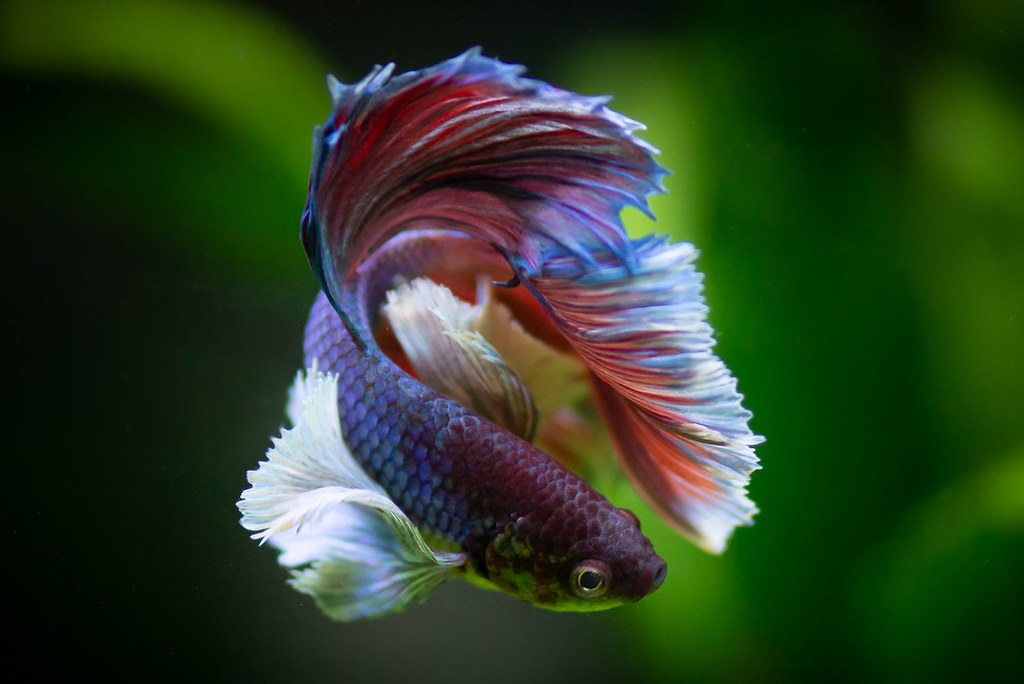Introduction
The Betta Fish (Betta splendens), also known as the Siamese Fighting Fish, is one of the most popular freshwater aquarium fish due to its vibrant colors, flowing fins, and unique personality. While often kept in small bowls, Betta fish care requires more than just a tiny tank. This guide covers everything you need to know about Betta fish tank setup, diet, breeding, and water parameters to keep your Betta healthy and thriving.

Quick Facts
Common Name: Betta Fish, Siamese Fighting Fish
Scientific Name: Betta splendens
Family: Osphronemidae
Lifespan: 3-5 years
Size: 2.5-3 inches (6-7.5 cm)
Tank Size: Minimum 5 gallons
Temperament: Males are aggressive, females are social
Diet: Carnivore
Water Parameters: pH 6.5-7.5, Temp 76-82°F
Natural Habitat & Betta Fish Behavior
Betta fish originate from the slow-moving, shallow waters of Thailand, Cambodia, and Vietnam. They inhabit rice paddies, swamps, and small streams with warm, oxygen-deficient water, using their labyrinth organ to breathe atmospheric air.
In captivity, Betta fish are known for their territorial behavior, especially males, which should not be housed together. Females can coexist in Betta sororities under specific conditions. Bettas are intelligent, responsive to their owners, and can even be trained to perform tricks.
Betta Fish Tank Setup & Requirements
Tank Size & Setup
- Minimum Tank Size: 5 gallons (larger is better for stability and enrichment)
- Best Setup: A well-planted tank with hiding spots, gentle filtration, and a heater
- Substrate: Fine sand or smooth gravel to protect delicate fins
Betta Fish Water Parameters
- Temperature: 76-82°F (24-28°C)
- pH Level: 6.5-7.5
- Water Hardness: 3-12 dGH
- Filtration: Sponge or low-flow filter to prevent strong currents
- Lighting: Moderate lighting with shaded areas
Betta Fish Tank Mates & Compatibility
Betta fish can coexist with certain species in a community tank, but caution is needed. Ideal Betta fish tank mates include:
- Compatible Tank Mates: Small peaceful fish (Ember Tetras, Corydoras, Kuhli Loaches, Mystery Snails, Shrimp)
- Avoid: Other male Bettas, Fin-nippers (Tiger Barbs), Large aggressive fish (Cichlids)
Betta Fish Diet & Feeding
What They Eat in the Wild
The Betta fish diet consists mainly of small insects, larvae, and zooplankton found in their native habitat.
Best Foods in Captivity
- Staple Diet: High-protein Betta pellets or flakes, such as Ultra Fresh Betta Pro Shrimp Patties
- Treats: Live or frozen foods (brine shrimp, bloodworms, daphnia)
- Feeding Frequency: 1-2 times per day, only as much as they can eat in 2 minutes
Betta Fish Breeding
Breeding Tank Setup
- Tank Size: 10 gallons (separate breeding tank recommended)
- Water Conditions: Warmer temperature, floating plants for bubble nest attachment
- Temperature: 78-82°F (26-28°C)
- Decor: Indian Almond leaves, smooth hiding spots
Breeding Process
- Bubble Nest Building – The male Betta constructs a bubble nest at the water’s surface.
- Courtship Display – The male flares his fins and guides the female under the nest.
- Egg-Laying & Fertilization – The female releases eggs, which the male collects and places in the nest.
- Parental Care – The male guards the nest and tends to the eggs until they hatch.
Fry Care
- First Foods: Infusoria or liquid fry food
- Growth Stages: Introduce baby brine shrimp after a few days
- Tank Conditions: Maintain stable, clean water to support fry development
Common Health Issues & Prevention
Common Diseases
| Disease | Symptoms | Treatment |
|---|---|---|
| Fin Rot | Frayed, discolored fins | Improve water quality, use antibacterial meds |
| Ich (White Spot Disease) | White cysts on body and fins | Increase temperature, use anti-parasitic meds |
| Velvet Disease | Gold or rust-colored dust on skin | Use copper-based medication, increase temperature |
Prevention Tips
- Maintain Clean Water: Perform regular water changes (25% weekly)
- Quarantine New Fish: Prevent disease spread
- Avoid Overfeeding: Prevents obesity and water pollution
FAQs
Q: Can Betta fish live in bowls?
A: No, Bettas require a heated, filtered tank of at least 5 gallons for long-term health.
Q: Do Betta fish need a heater?
A: Yes, Bettas are tropical fish and need a heater to maintain a stable temperature of 76-82°F.
Q: Can female Betta fish live together?
A: Yes, in a properly set up Betta sorority, with at least 5 females and plenty of hiding spots.
Q: How can I tell if my Betta is happy?
A: A happy Betta will be active, display vibrant colors, flare occasionally, and build bubble nests.
Conclusion
The Betta Fish is a captivating, intelligent, and rewarding pet when provided with proper care. By ensuring the right Betta fish tank setup, diet, and water parameters, you can enjoy a healthy, thriving Betta for years to come.
